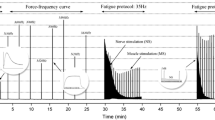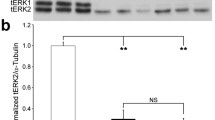Abstract
We generated a mouse line with a missense mutation (S248F) in the gene (CHRNA4) encoding the α4 subunit of neuronal nicotinic acetylcholine receptor (nAChR). Mutant mice demonstrate brief nicotine induced dystonia that resembles the clinical events seen in patients with the same mutation. Drug-induced dystonia is more pronounced in female mice, thus our aim was to determine if the S248F mutation changed the properties of fast- and slow-twitch muscle fibres from female mutant mice. Reverse transcriptase-PCR confirmed CHRNA4 gene expression in the brain but not skeletal muscles in normal and mutant mice. Ca2+ and Sr2+ force activation curves were obtained using skinned muscle fibres prepared from slow-twitch (soleus) and fast-twitch (EDL) muscles. Two significant results were found: (1) the (pCa50 − pSr50) value from EDL fibres was smaller in mutant mice than in wild type (1.01 vs. 1.30), (2) the percentage force produced at pSr 5.5 was larger in mutants than in wild type (5.76 vs. 0.24%). Both results indicate a shift to slow-twitch characteristics in the mutant. This conclusion is supported by the identification of the myosin heavy chain (MHC) isoforms. Mutant EDL fibres expressed MHC I (usually only found in slow-twitch fibres) as well as MHC IIa. Despite the lack of spontaneous dystonic events, our findings suggest that mutant mice may be having subclinical events or the mutation results in a chronic alteration to muscle neural input.



Similar content being viewed by others
References
Ashley CC, Moisescu DG (1977) Effect of changing the composition of the bathing solutions upon the isometric tension–pCa relationship in bundles of crustacean myofibrils. J Physiol 270:627–652
Bicer S, Reiser PJ (2004) Myosin light chain isoform expression among single mammalian skeletal muscle fibers: species variations. J Muscle Res Cell Motil 25:623–633. doi:10.1007/s10974-004-5070-9
Bortolotto SK, Stephenson DG, Stephenson GM (1999) Fiber type populations and Ca2+-activation properties of single fibers in soleus muscles from SHR and WKY rats. Am J Physiol 276:C628–C637
Bortolotto SK, Cellini M, Stephenson DG, Stephenson GM (2000) MHC isoform composition and Ca(2+)- or Sr(2+)-activation properties of rat skeletal muscle fibers. Am J Physiol Cell Physiol 279:C1564–C1577
Brown WE, Salmons S, Whalen RG (1983) The sequential replacement of myosin subunit isoforms during muscle type transformation induced by long term electrical stimulation. J Biol Chem 258:14686–14692
Buller AJ, Eccles JC, Eccles RM (1960) Interactions between motoneurones and muscles in respect of the characteristic speeds of their responses. J Physiol 150:417–439
Close R (1969) Dynamic properties of fast and slow skeletal muscles of the rat after nerve cross-union. J Physiol 204:331–346
Corriveau RA, Romano SJ, Conroy WG, Oliva L, Berg DK (1995) Expression of neuronal acetylcholine receptor genes in vertebrate skeletal muscle during development. J Neurosci 15:1372–1383
Cox H, Costin-Kelly NM, Ramani P, Whitehouse WP (2000) An established case of dentatorubral pallidoluysian atrophy (DRPLA) with unusual features on muscle biopsy. Eur J Paediatr Neurol 4:119–123. doi:10.1053/ejpn.2000.0279
Edstrom L, Gremski W, Wroblewski R (1979) Sulphur and phosphorus content in relation to fibre composition and atrophy of skeletal muscle in patients with Parkinson’s disease. J Neurol Sci 41:311–323. doi:10.1016/0022-510X(79)90092-3
Fink RH, Stephenson DG, Williams DA (1986) Calcium and strontium activation of single skinned muscle fibres of normal and dystrophic mice. J Physiol 373:513–525
Fink RH, Stephenson DG, Williams DA (1990) Physiological properties of skinned fibres from normal and dystrophic (Duchenne) human muscle activated by Ca2+ and Sr2+. J Physiol 420:337–353
Geiger PC, Cody MJ, Sieck GC (1999) Force-calcium relationship depends on myosin heavy chain and troponin isoforms in rat diaphragm muscle fibers. J Appl Physiol 87:1894–1900
Grabarek Z, Tao T, Gergely J (1992) Molecular mechanism of troponin-C function. J Muscle Res Cell Motil 13:383–393. doi:10.1007/BF01738034
Gundersen K, Leberer E, Lomo T, Pette D, Staron RS (1988) Fibre types, calcium-sequestering proteins and metabolic enzymes in denervated and chronically stimulated muscles of the rat. J Physiol 398:177–189
Hayashi R, Hashimoto T, Tada T, Ikeda S (2001) Relation between changes in long-latency stretch reflexes and muscle stiffness in Parkinson’s disease—comparison before and after unilateral pallidotomy. Clin Neurophysiol 112:1814–1821. doi:10.1016/S1388-2457(01)00642-3
Hennig R, Lomo T (1985) Firing patterns of motor units in normal rats. Nature 314:164–166. doi:10.1038/314164a0
Hill AV (1910) A new mathematical treatment of changes of ionic concentration in muscle and nerve under the action of electric currents, with a theory as to their mode of excitation. J Physiol 40:190–224
Hogg RC, Raggenbass M, Bertrand D (2003) Nicotinic acetylcholine receptors: from structure to brain function. Rev Physiol Biochem Pharmacol 147:1–46. doi:10.1007/s10254-003-0005-1
Hoh JF (1975) Selective and non-selective reinnervation of fast-twitch and slow-twitch rat skeletal muscle. J Physiol 251:791–801
Kischel P, Bastide B, Muller M, Dubail F, Offredi F, Jin JP, Mounier Y, Martial J (2005) Expression and functional properties of four slow skeletal troponin T isoforms in rat muscles. Am J Physiol Cell Physiol 289(2):C437–C443
Lynch GS, Stephenson DG, Williams DA (1995) Analysis of Ca2+ and Sr2+ activation characteristics in skinned muscle fibre preparations with different proportions of myofibrillar isoforms. J Muscle Res Cell Motil 16:65–78. doi:10.1007/BF00125311
Mishina M, Takai T, Imoto K, Noda M, Takahashi T, Numa S, Methfessel C, Sakmann B (1986) Molecular distinction between fetal and adult forms of muscle acetylcholine receptor. Nature 321:406–411. doi:10.1038/321406a0
Moisescu DG (1976) Kinetics of reaction in calcium-activated skinned muscle fibres. Nature 262:610–613. doi:10.1038/262610a0
O’Connell B, Nguyen LT, Stephenson GM (2004a) A single-fibre study of the relationship between MHC and TnC isoform composition in rat skeletal muscle. Biochem J 378:269–274. doi:10.1042/BJ20031170
O’Connell B, Stephenson DG, Blazev R, Stephenson GM (2004b) Troponin C isoform composition determines differences in Sr(2+)-activation characteristics between rat diaphragm fibers. Am J Physiol Cell Physiol 287:C79–C87. doi:10.1152/ajpcell.00555.2003
Pette D, Schnez U (1977) Coexistence of fast and slow type myosin light chains in single muscle fibres during transformation as induced by long term stimulation. FEBS Lett 83:128–130. doi:10.1016/0014-5793(77)80656-X
Pette D, Staron RS (1990) Cellular and molecular diversities of mammalian skeletal muscle fibers. Rev Physiol Biochem Pharmacol 116:1–76
Phillips HA, Scheffer IE, Berkovic SF, Hollway GE, Sutherland GR, Mulley JC (1995) Localization of a gene for autosomal dominant nocturnal frontal lobe epilepsy to chromosome 20q 13.2. Nat Genet 10:117–118. doi:10.1038/ng0595-117
Piquet F, Stevens L, Butler-Browne GS, Mounier Y (1997) Contractile properties and myosin heavy chain composition of newborn rat soleus muscles at different stages of postnatal development. J Muscle Res Cell Motil 18:71–79. doi:10.1023/A:1018633017143
Rees BB, Stephenson DG (1987) Thermal dependence of maximum Ca2+-activated force in skinned muscle fibres of the toad Bufo marinus acclimated at different temperatures. J Exp Biol 129:309–327
Rossi B, Siciliano G, Carboncini MC, Manca ML, Massetani R, Viacava P, Muratorio A (1996) Muscle modifications in Parkinson’s disease: myoelectric manifestations. Electroencephalogr Clin Neurophysiol 101:211–218. doi:10.1016/0924-980X(96)94672-X
Rubinstein N, Mabuchi K, Pepe F, Salmons S, Gergely J, Sréter F (1978) Use of type-specific antimyosins to demonstrate the transformation of individual fibers in chronically stimulated rabbit fast muscles. J Cell Biol 79:252–261. doi:10.1083/jcb.79.1.252
Sala C, Kimura I, Santoro G, Kimura M, Fumagalli G (1996) Expression of two neuronal nicotinic receptor subunits in innervated and denervated adult rat muscle. Neurosci Lett 215:71–74. doi:10.1016/0304-3940(96)12923-2
Salmons S (1980) Functional adaptation in skeletal muscle. Trends Neurosci 3:134–137. doi:10.1016/0166-2236(80)90050-8
Salmons S, Henriksson J (1981) The adaptive response of skeletal muscle to increased use. Muscle Nerve 4:94–105. doi:10.1002/mus.880040204
Salmons S, Sréter FA (1976) Significance of impulse activity in the transformation of skeletal muscle type. Nature 263:30–34. doi:10.1038/263030a0
Salmons S, Vrbovà G (1969) The influence of activity on some contractile characteristics of mammalian fast and slow muscles. J Physiol 201:535–549
Schachat FH, Diamond MS, Brandt PW (1987) Effect of different troponin T-tropomyosin combinations on thin filament activation. J Mol Biol 198:551–554. doi:10.1016/0022-2836(87)90300-7
Scheffer IE, Bhatia KP, Lopes-Cendes I, Fish, Marsden CD, Andermann E, Andermann F, Desbiens R, Keene D, Cendes F et al (1995) Autosomal dominant nocturnal frontal lobe epilepsy. A distinctive clinical disorder. Brain 118(Pt 1):61–73. doi:10.1093/brain/118.1.61
Sharott A, Grosse P, Kuhn AA, Salih F, Engel AK, Kupsch A, Schneider GH, Krauss JK, Brown P (2008) Is the synchronization between pallidal and muscle activity in primary dystonia due to peripheral afferance or a motor drive? Brain 131:473–484. doi:10.1093/brain/awm324
Sliwinski A, Stanic D, Finkelstein DI, Ilic M, West JM, Dooley PC (2005) Alterations in the proportions of skeletal muscle proteins following a unilateral lesion to the substantia nigra pars compacta of rats. J Muscle Res Cell Motil 26:149–155. doi:10.1007/s10974-005-6833-7
Sréter FA, Gergely J, Salmons S, Romanul F (1973) Synthesis by fast muscle of myosin light chains characteristic of slow muscle in response to long-term stimulation. Nat New Biol 241:17–19
Steinlein OK, Mulley JC, Propping P, Wallace RH, Phillips HA, Sutherland GR, Scheffer IE, Berkovic SF (1995) A missense mutation in the neuronal nicotinic acetylcholine receptor alpha 4 subunit is associated with autosomal dominant nocturnal frontal lobe epilepsy. Nat Genet 11:201–203. doi:10.1038/ng1095-201
Stephenson DG (2006) Tubular system excitability: an essential component of excitation-contraction coupling in fast-twitch fibres of vertebrate skeletal muscle. J Muscle Res Cell Motil 27:259–274. doi:10.1007/s10974-006-9073-6
Stephenson DG, Williams DA (1982) Effects of sarcomere length on the force–pCa relation in fast- and slow-twitch skinned muscle fibres from the rat. J Physiol 333:637–653
Syrový I (1987) Isoforms of contractile proteins. Prog Biophys Mol Biol 49:1–27. doi:10.1016/0079-6107(87)90007-1
Takakusaki K, Habaguchi T, Ohtinata-Sugimoto J, Saitoh K, Sakamoto T (2003) Basal ganglia efferents to the brainstem centers controlling postural muscle tone and locomotion: a new concept for understanding motor disorders in basal ganglia dysfunction. Neuroscience 119:293–308. doi:10.1016/S0306-4522(03)00095-2
Takakusaki K, Habaguchi T, Saitoh K, Kohyama J (2004a) Changes in the excitability of hindlimb motoneurons during muscular atonia induced by stimulating the pedunculopontine tegmental nucleus in cats. Neuroscience 124:467–480. doi:10.1016/j.neuroscience.2003.12.016
Takakusaki K, Oohinata-Sugimoto J, Saitoh K, Habaguchi T (2004b) Role of basal ganglia-brainstem systems in the control of postural muscle tone and locomotion. Prog Brain Res 143:231–237. doi:10.1016/S0079-6123(03)43023-9
Takakusaki K, Saitoh K, Harada H, Kashiwayanagi M (2004c) Role of basal ganglia-brainstem pathways in the control of motor behaviors. Neurosci Res 50:137–151. doi:10.1016/j.neures.2004.06.015
Talmadge RJ, Roy RR (1993) Electrophoretic separation of rat skeletal muscle myosin heavy-chain isoforms. J Appl Physiol 75:2337–2340
Teper Y, Whyte D, Cahir E, Lester HA, Grady SR, Marks MJ, Cohen BN, Fonck C, McClure-Begley T, McIntosh JM, Labarca C, Lawrence A, Chen F, Gantois I, Davies PJ, Petrou S, Murphy M, Waddington J, Horne MK, Berkovic SF, Drago J (2007) Nicotine-induced dystonic arousal complex in a mouse line harboring a human autosomal-dominant nocturnal frontal lobe epilepsy mutation. J Neurosci 27:10128–10142. doi:10.1523/JNEUROSCI.3042-07.2007
West JM, Stephenson DG (1993) Ca2+ and Sr2+ activation properties of skinned muscle fibres with different regulatory systems from crustacea and rat. J Physiol 462:579–596
West JM, Barclay CJ, Luff AR, Walker DW (1999) Developmental changes in the activation properties and ultrastructure of fast- and slow-twitch muscles from fetal sheep. J Muscle Res Cell Motil 20:249–264. doi:10.1023/A:1005433809414
Wong JY, Ross SA, McColl C, Massalas JS, Powney E, Finkelstein DI, Clark M, Horne MK, Berkovic SF, Drago J (2002) Proconvulsant-induced seizures in alpha(4) nicotinic acetylcholine receptor subunit knockout mice. Neuropharmacology 43:55–64. doi:10.1016/S0028-3908(02)00067-9
Acknowledgments
This study was supported by a project grant from the National Health and Medical Research Council (NHMRC). J.D. is a NHMRC practitioner fellow. Authors would like to thank Jim Massalas (Howard Florey Institute) for his assistance with the S248F mouse strain and Prof. George Stephenson (La Trobe University) for helpful suggestions and critically reading the manuscript.
Author information
Authors and Affiliations
Corresponding author
Electronic supplementary material
Below is the link to the electronic supplementary material.
Supplementary material 1 (MPG 21790 kb)
Rights and permissions
About this article
Cite this article
Cannata, D.J., Finkelstein, D.I., Gantois, I. et al. Altered fast- and slow-twitch muscle fibre characteristics in female mice with a (S248F) knock-in mutation of the brain neuronal nicotinic acetylcholine receptor. J Muscle Res Cell Motil 30, 73–83 (2009). https://doi.org/10.1007/s10974-009-9177-x
Received:
Accepted:
Published:
Issue Date:
DOI: https://doi.org/10.1007/s10974-009-9177-x




